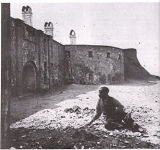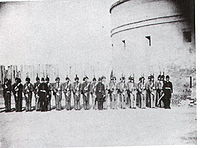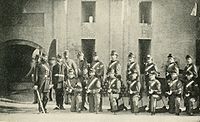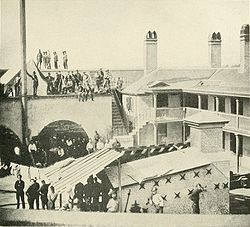
Castle Pinckney
Encyclopedia
Castle Pinckney was a small masonry fortification constructed by the United States
government by 1810 in the harbor of Charleston, South Carolina
. It was used very briefly as a prisoner-of-war camp
(six weeks) and artillery
position during the American Civil War
.
Located on Shutes' Folly Island a mile offshore from Charleston, the newer Castle fort was built over the ruins of an older fortification. Construction for the original log and earthen fort, named "Fort Pinckney" after the Revolutionary War
hero Charles Cotesworth Pinckney
, began in 1797 and was meant to protect the city from a possible naval attack when war with France
seemed imminent. It was completed in 1804 but a severe hurricane in September of that year virtually destroyed it, and a replacement brick and mortar castle structure was erected in 1809–1810 called "Castle Pinckney". It was garrisoned through the War of 1812
, but saw no action. Afterwards, Castle Pinckney was abandoned for several years and fell into disrepair.
The fort was re-garrisoned and a sea wall was completed during the Nullification Crisis
of 1832, when President
Andrew Jackson
prepared to collect a controversial tariff
by military force if necessary. After that brief period of activity, the fort again fell into disuse and was primarily a storehouse for gunpowder
and other military supplies.

 By the Civil War, Castle Pinckney was part of a network of defensive positions in the harbor, which included the larger and more strategically placed Fort Sumter
By the Civil War, Castle Pinckney was part of a network of defensive positions in the harbor, which included the larger and more strategically placed Fort Sumter
and Fort Moultrie, and other smaller earthworks and fortifications. Castle Pinckney's armament in 1860 consisted of fourteen 24-pounders, four 42-pounders, four 8-inch howitzer
s, one 10-inch and one 8-inch mortar
and four light fieldpieces to protect its flanks. On December 27, 1860, one week after South Carolina seceded
from the Union
, the fort was surrendered to South Carolina militia
by its small garrison, which retired to Fort Sumter to join Major Robert Anderson
. Castle Pinckney became the first Federal military position seized forcefully by a Southern
state government. Three days later, the Charleston Arsenal
joined Castle Pinckney in falling to the militia. After the subsequent attack on Fort Sumter, the Charleston Zouave Cadets manned Castle Pinckney.
 One hundred and fifty-four Union Army
One hundred and fifty-four Union Army
prisoners of war
(120 enlisted, 34 officers) captured during the First Battle of Manassas and previously incarcerated at Ligon's Prison arrived at Charleston on September 10, 1861 and were kept at the Charleston City Jail until the lower casements of Castle Pinckney were converted into cells. According to the Charleston Mercury, Richmond officials had selected "..chiefly from among those who have evidenced the most insolent and insubordinate disposition". On September 18, prisoners from the 11th NY Fire Zouaves, 69th NY ("Irish") Regiment, 79th NY Regiment, and 8th Michigan Infantry were transferred to Castle Pinckney. They were allowed to wander during the day and were confined to cells only at night. The Castle quickly proved to be too small and inadequate however for permanent confinement and the prisoners were transferred back to the Charleston City Jail on October 31, 1861 after only six weeks. After the prisoners were removed, the fort was strengthened with earthen embankments and additional mortars and Columbiads on the barbette
tier. On December 12, the prisoners were transferred back to the island following a fire which had burned a large section of Charleston and damaged the jail. They remained for just over a week with many sleeping on the inner parade ground before being transferred.
After the Civil War, the fort was modernized for possible use during the Spanish-American War
but again was not needed. Some sources suggest that the fort never fired a single hostile shot during its lengthy existence. Parts of the old brick walls and casemates were dismantled in 1890 to make way for a harbor lighthouse
, which operated into the 20th century. Castle Pinckney was declared a U.S. National Monument
in 1924 by presidential proclamation. In 1951, Congress passed a bill to abolish Castle Pinckney National Monument and transferred it back to U.S. Army Corps of Engineers.
A local Sons of Confederate Veterans
fraternal post took over management and care of the island in the late 1960s and attempted to preserve it and establish a museum. Castle Pinckney was listed on the National Register of Historic Places
in 1970. Eventually, unable to raise the needed funds, the SCV allowed the fort to revert to state ownership. Castle Pinckney has recently undergone some limited restoration efforts. Due its location on an isolated shoal in the middle of the harbor, access is limited, if not nonexistent, and maintenance near impossible. It is gradually being reclaimed by nature.
In June, 2011, Castle Pinckney was sold to the Fort Sumter Camp No. 1269, Sons of Confederate Veterans for $10.
United States
The United States of America is a federal constitutional republic comprising fifty states and a federal district...
government by 1810 in the harbor of Charleston, South Carolina
Charleston, South Carolina
Charleston is the second largest city in the U.S. state of South Carolina. It was made the county seat of Charleston County in 1901 when Charleston County was founded. The city's original name was Charles Towne in 1670, and it moved to its present location from a location on the west bank of the...
. It was used very briefly as a prisoner-of-war camp
Prisoner-of-war camp
A prisoner-of-war camp is a site for the containment of combatants captured by their enemy in time of war, and is similar to an internment camp which is used for civilian populations. A prisoner of war is generally a soldier, sailor, or airman who is imprisoned by an enemy power during or...
(six weeks) and artillery
Artillery
Originally applied to any group of infantry primarily armed with projectile weapons, artillery has over time become limited in meaning to refer only to those engines of war that operate by projection of munitions far beyond the range of effect of personal weapons...
position during the American Civil War
American Civil War
The American Civil War was a civil war fought in the United States of America. In response to the election of Abraham Lincoln as President of the United States, 11 southern slave states declared their secession from the United States and formed the Confederate States of America ; the other 25...
.
Located on Shutes' Folly Island a mile offshore from Charleston, the newer Castle fort was built over the ruins of an older fortification. Construction for the original log and earthen fort, named "Fort Pinckney" after the Revolutionary War
American Revolution
The American Revolution was the political upheaval during the last half of the 18th century in which thirteen colonies in North America joined together to break free from the British Empire, combining to become the United States of America...
hero Charles Cotesworth Pinckney
Charles Cotesworth Pinckney
Charles Cotesworth “C. C.” Pinckney , was an early American statesman of South Carolina, Revolutionary War veteran, and delegate to the Constitutional Convention. He was twice nominated by the Federalist Party as their presidential candidate, but he did not win either election.-Early life and...
, began in 1797 and was meant to protect the city from a possible naval attack when war with France
France
The French Republic , The French Republic , The French Republic , (commonly known as France , is a unitary semi-presidential republic in Western Europe with several overseas territories and islands located on other continents and in the Indian, Pacific, and Atlantic oceans. Metropolitan France...
seemed imminent. It was completed in 1804 but a severe hurricane in September of that year virtually destroyed it, and a replacement brick and mortar castle structure was erected in 1809–1810 called "Castle Pinckney". It was garrisoned through the War of 1812
War of 1812
The War of 1812 was a military conflict fought between the forces of the United States of America and those of the British Empire. The Americans declared war in 1812 for several reasons, including trade restrictions because of Britain's ongoing war with France, impressment of American merchant...
, but saw no action. Afterwards, Castle Pinckney was abandoned for several years and fell into disrepair.
The fort was re-garrisoned and a sea wall was completed during the Nullification Crisis
Nullification Crisis
The Nullification Crisis was a sectional crisis during the presidency of Andrew Jackson created by South Carolina's 1832 Ordinance of Nullification. This ordinance declared by the power of the State that the federal Tariff of 1828 and 1832 were unconstitutional and therefore null and void within...
of 1832, when President
President of the United States
The President of the United States of America is the head of state and head of government of the United States. The president leads the executive branch of the federal government and is the commander-in-chief of the United States Armed Forces....
Andrew Jackson
Andrew Jackson
Andrew Jackson was the seventh President of the United States . Based in frontier Tennessee, Jackson was a politician and army general who defeated the Creek Indians at the Battle of Horseshoe Bend , and the British at the Battle of New Orleans...
prepared to collect a controversial tariff
Tariff
A tariff may be either tax on imports or exports , or a list or schedule of prices for such things as rail service, bus routes, and electrical usage ....
by military force if necessary. After that brief period of activity, the fort again fell into disuse and was primarily a storehouse for gunpowder
Gunpowder
Gunpowder, also known since in the late 19th century as black powder, was the first chemical explosive and the only one known until the mid 1800s. It is a mixture of sulfur, charcoal, and potassium nitrate - with the sulfur and charcoal acting as fuels, while the saltpeter works as an oxidizer...
and other military supplies.


Fort Sumter
Fort Sumter is a Third System masonry coastal fortification located in Charleston Harbor, South Carolina. The fort is best known as the site upon which the shots initiating the American Civil War were fired, at the Battle of Fort Sumter.- Construction :...
and Fort Moultrie, and other smaller earthworks and fortifications. Castle Pinckney's armament in 1860 consisted of fourteen 24-pounders, four 42-pounders, four 8-inch howitzer
Howitzer
A howitzer is a type of artillery piece characterized by a relatively short barrel and the use of comparatively small propellant charges to propel projectiles at relatively high trajectories, with a steep angle of descent...
s, one 10-inch and one 8-inch mortar
Mortar (weapon)
A mortar is an indirect fire weapon that fires explosive projectiles known as bombs at low velocities, short ranges, and high-arcing ballistic trajectories. It is typically muzzle-loading and has a barrel length less than 15 times its caliber....
and four light fieldpieces to protect its flanks. On December 27, 1860, one week after South Carolina seceded
Secession
Secession is the act of withdrawing from an organization, union, or especially a political entity. Threats of secession also can be a strategy for achieving more limited goals.-Secession theory:...
from the Union
Union (American Civil War)
During the American Civil War, the Union was a name used to refer to the federal government of the United States, which was supported by the twenty free states and five border slave states. It was opposed by 11 southern slave states that had declared a secession to join together to form the...
, the fort was surrendered to South Carolina militia
Militia
The term militia is commonly used today to refer to a military force composed of ordinary citizens to provide defense, emergency law enforcement, or paramilitary service, in times of emergency without being paid a regular salary or committed to a fixed term of service. It is a polyseme with...
by its small garrison, which retired to Fort Sumter to join Major Robert Anderson
Major Robert Anderson
Robert Anderson was an American military leader. He served as a Union Army officer in the American Civil War, known for his command of Fort Sumter at the start of the war. He is often referred to as Major Robert Anderson, referring to his rank at Fort Sumter...
. Castle Pinckney became the first Federal military position seized forcefully by a Southern
Southern United States
The Southern United States—commonly referred to as the American South, Dixie, or simply the South—constitutes a large distinctive area in the southeastern and south-central United States...
state government. Three days later, the Charleston Arsenal
Charleston Arsenal
The Charleston Arsenal was a United States Army arsenal facility in Charleston, South Carolina seized by state militia at the outbreak of the American Civil War....
joined Castle Pinckney in falling to the militia. After the subsequent attack on Fort Sumter, the Charleston Zouave Cadets manned Castle Pinckney.

Union Army
The Union Army was the land force that fought for the Union during the American Civil War. It was also known as the Federal Army, the U.S. Army, the Northern Army and the National Army...
prisoners of war
Prisoner of war
A prisoner of war or enemy prisoner of war is a person, whether civilian or combatant, who is held in custody by an enemy power during or immediately after an armed conflict...
(120 enlisted, 34 officers) captured during the First Battle of Manassas and previously incarcerated at Ligon's Prison arrived at Charleston on September 10, 1861 and were kept at the Charleston City Jail until the lower casements of Castle Pinckney were converted into cells. According to the Charleston Mercury, Richmond officials had selected "..chiefly from among those who have evidenced the most insolent and insubordinate disposition". On September 18, prisoners from the 11th NY Fire Zouaves, 69th NY ("Irish") Regiment, 79th NY Regiment, and 8th Michigan Infantry were transferred to Castle Pinckney. They were allowed to wander during the day and were confined to cells only at night. The Castle quickly proved to be too small and inadequate however for permanent confinement and the prisoners were transferred back to the Charleston City Jail on October 31, 1861 after only six weeks. After the prisoners were removed, the fort was strengthened with earthen embankments and additional mortars and Columbiads on the barbette
Barbette
A barbette is a protective circular armour feature around a cannon or heavy artillery gun. The name comes from the French phrase en barbette referring to the practice of firing a field gun over a parapet rather than through an opening . The former gives better angles of fire but less protection...
tier. On December 12, the prisoners were transferred back to the island following a fire which had burned a large section of Charleston and damaged the jail. They remained for just over a week with many sleeping on the inner parade ground before being transferred.
After the Civil War, the fort was modernized for possible use during the Spanish-American War
Spanish-American War
The Spanish–American War was a conflict in 1898 between Spain and the United States, effectively the result of American intervention in the ongoing Cuban War of Independence...
but again was not needed. Some sources suggest that the fort never fired a single hostile shot during its lengthy existence. Parts of the old brick walls and casemates were dismantled in 1890 to make way for a harbor lighthouse
Castle Pinckney Light
Castle Pinckney Light is a former lighthouse on Shutes' Folly Island in Charleston Harbor, Charleston County, South Carolina.Castle Pinckney was a small fort that was built in the 1790s. It was occupied by Confederate forces during the Civil War.-History:...
, which operated into the 20th century. Castle Pinckney was declared a U.S. National Monument
U.S. National Monument
A National Monument in the United States is a protected area that is similar to a National Park except that the President of the United States can quickly declare an area of the United States to be a National Monument without the approval of Congress. National monuments receive less funding and...
in 1924 by presidential proclamation. In 1951, Congress passed a bill to abolish Castle Pinckney National Monument and transferred it back to U.S. Army Corps of Engineers.
A local Sons of Confederate Veterans
Sons of Confederate Veterans
Sons of Confederate Veterans is an American national heritage organization with members in all fifty states and in almost a dozen countries in Europe, Australia and South America...
fraternal post took over management and care of the island in the late 1960s and attempted to preserve it and establish a museum. Castle Pinckney was listed on the National Register of Historic Places
National Register of Historic Places
The National Register of Historic Places is the United States government's official list of districts, sites, buildings, structures, and objects deemed worthy of preservation...
in 1970. Eventually, unable to raise the needed funds, the SCV allowed the fort to revert to state ownership. Castle Pinckney has recently undergone some limited restoration efforts. Due its location on an isolated shoal in the middle of the harbor, access is limited, if not nonexistent, and maintenance near impossible. It is gradually being reclaimed by nature.
In June, 2011, Castle Pinckney was sold to the Fort Sumter Camp No. 1269, Sons of Confederate Veterans for $10.
See also
- List of Civil War POW Prisons and Camps
External links
- Civil War Prisons
- The American Civil War; Prisoner of War Camps
- Castle Pinckney, at South Carolina Department of Archives and History
- Castle Pinckney restoration
- National Park Service overview of Castle Pinckney

